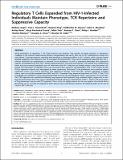| dc.contributor.author | Angin, Mathieu | |
| dc.contributor.author | Klarenbeek, Paul L. | |
| dc.contributor.author | King, Melanie | |
| dc.contributor.author | Sharma, Siddhartha M. | |
| dc.contributor.author | Moodley, Eshia S. | |
| dc.contributor.author | Rezai, Ashley | |
| dc.contributor.author | Piechocka-Trocha, Alicja | |
| dc.contributor.author | Toth, Ildiko | |
| dc.contributor.author | Chan, Andrew T. | |
| dc.contributor.author | Goulder, Philip J. R. | |
| dc.contributor.author | Ndung'u, Thumbi | |
| dc.contributor.author | Kwon, Douglas | |
| dc.contributor.author | Addo, Marylyn M. | |
| dc.date.accessioned | 2014-04-15T20:19:59Z | |
| dc.date.available | 2014-04-15T20:19:59Z | |
| dc.date.issued | 2014-02 | |
| dc.date.submitted | 2013-08 | |
| dc.identifier.uri | http://hdl.handle.net/1721.1/86176 | |
| dc.description.abstract | While modulation of regulatory T cell (Treg) function and adoptive Treg transfer are being explored as therapeutic modalities in the context of autoimmune diseases, transplantation and cancer, their role in HIV-1 pathogenesis remains less well defined. Controversy persists regarding their beneficial or detrimental effects in HIV-1 disease, which warrants further detailed exploration. Our objectives were to investigate if functional CD4+ Tregs can be isolated and expanded from HIV-1-infected individuals for experimental or potential future therapeutic use and to determine phenotype and suppressive capacity of expanded Tregs from HIV-1 positive blood and tissue. Tregs and conventional T cell controls were isolated from blood and gut-associated lymphoid tissue of individuals with HIV-1 infection and healthy donors using flow-based cell-sorting. The phenotype of expanded Tregs was assessed by flow-cytometry and quantitative PCR. T-cell receptor ß-chain (TCR-β) repertoire diversity was investigated by deep sequencing. Flow-based T-cell proliferation and chromium release cytotoxicity assays were used to determine Treg suppressive function. Tregs from HIV-1 positive individuals, including infants, were successfully expanded from PBMC and GALT. Expanded Tregs expressed high levels of FOXP3, CTLA4, CD39 and HELIOS and exhibited a highly demethylated TSDR (Treg-specific demethylated region), characteristic of Treg lineage. The TCRß repertoire was maintained following Treg expansion and expanded Tregs remained highly suppressive in vitro. Our data demonstrate that Tregs can be expanded from blood and tissue compartments of HIV-1+ donors with preservation of Treg phenotype, function and TCR repertoire. These results are highly relevant for the investigation of potential future therapeutic use, as currently investigated for other disease states and hold great promise for detailed studies on the role of Tregs in HIV-1 infection. | en_US |
| dc.description.sponsorship | Elizabeth Glaser Pediatric AIDS Foundation (Pediatric HIV Vaccine Program Award MV-00-9-900-1429-0-00) | en_US |
| dc.description.sponsorship | Massachusetts General Hospital. Executive Committee on Research (MGH/ECOR Physician Scientist Development Award) | en_US |
| dc.description.sponsorship | National Institutes of Health (U.S.) (NIH NIAID (KO8 AI074405)) | en_US |
| dc.description.sponsorship | National Institutes of Health (U.S.) (NIH NIAID AI074405-03S1) | en_US |
| dc.description.sponsorship | Massachusetts General Hospital (William F. Milton Fund) | en_US |
| dc.description.sponsorship | Harvard University. Center for AIDS Research (CFAR Scholar Award) | en_US |
| dc.description.sponsorship | Massachusetts General Hospital. Center for the Study Inflammatory Bowel Disease (P30DK043351) | en_US |
| dc.description.sponsorship | Harvard University. Center for AIDS Research (NIH funded program (5P30AI060354-09) | en_US |
| dc.language.iso | en_US | |
| dc.publisher | Public Library of Science | en_US |
| dc.relation.isversionof | http://dx.doi.org/10.1371/journal.pone.0086920 | en_US |
| dc.rights | Creative Commons Attribution | en_US |
| dc.rights.uri | http://creativecommons.org/licenses/by/4.0/ | en_US |
| dc.source | PLoS | en_US |
| dc.title | Regulatory T Cells Expanded from Hiv-1-Infected Individuals Maintain Phenotype, Tcr Repertoire and Suppressive Capacity | en_US |
| dc.type | Article | en_US |
| dc.identifier.citation | Angin M, Klarenbeek PL, King M, Sharma SM, Moodley ES, et al. (2014) Regulatory T Cells Expanded from HIV-1-Infected Individuals Maintain Phenotype, TCR Repertoire and Suppressive Capacity. PLoS ONE 9(2): e86920. | en_US |
| dc.contributor.department | Koch Institute for Integrative Cancer Research at MIT | en_US |
| dc.contributor.mitauthor | Kwon, Douglas | en_US |
| dc.relation.journal | Plos One | en_US |
| dc.eprint.version | Final published version | en_US |
| dc.type.uri | http://purl.org/eprint/type/JournalArticle | en_US |
| eprint.status | http://purl.org/eprint/status/PeerReviewed | en_US |
| dspace.orderedauthors | Angin, Mathieu; Klarenbeek, Paul L.; King, Melanie; Sharma, Siddhartha M.; Moodley, Eshia S.; Rezai, Ashley; Piechocka-Trocha, Alicja; Toth, Ildiko; Chan, Andrew T.; Goulder, Philip J.; Ndung'u, Thumbi; Kwon, Douglas S.; Addo, Marylyn M. | en_US |
| mit.license | PUBLISHER_CC | en_US |
| mit.metadata.status | Complete | |
